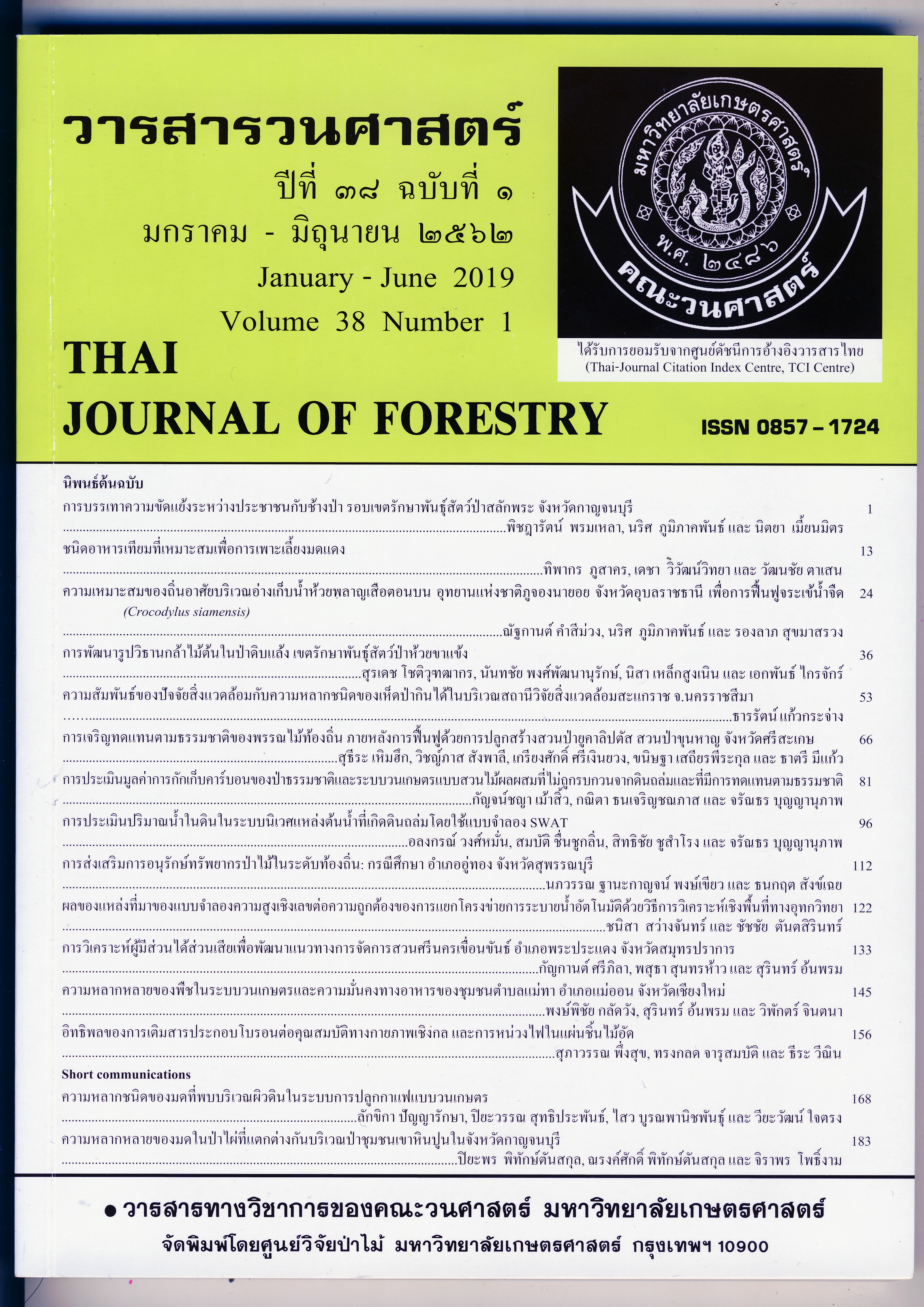Effect of Digital Elevation Model Sources on Accuracy of Automated Drainage Network Extraction based on Hydrological Spatial Analysis Methods
Main Article Content
Abstract
The automated drainage network extraction is a hydrological spatial analysis processes
use to derive drainage pattern of a watershed area based on the digital elevation model (DEM).
Different sources of the DEM may affect the obtained network. This study compared the effects of
using DEM from different sources including DEM from Land Development Department (LDD),
ASTER GDEM, SRTM and DEM obtained from ANUDEM algorithm on automatic drainage
network extraction. Accuracy of the extracted network was verified using field observation data.
Three different terrain characteristics of selected watershed including steep slope, moderate slope
area and flat area were compared.
It was found that the appropriated drainage area threshold (DAT) derived from different
DEM source were different. The higher DEM resolution, the lesser DAT was obtained. Drainage
density that derived from automated extraction method was larger than that from the topographic
map. The highest accuracy of extracted drainage network using the LDD DEM in the steep
watershed area was found while that from the ANUDEM, SRTM and ASTER GDEM were smaller.
The accuracy are equal to 85.83, 40.73, 38.75 and 29.55 percent, respectively. In the moderate
slope watershed, it was found that the accuracy of extracted drainage from SRTM was the highest
and smaller when the ANUDEM, SRTM and ASTER GDEM were used. The accuracy are equal
to 73.33, 72.45, 31.49 and 30.03 percent, respectively. The accuracy of the extracted drainage
network obtained from the different DEMs of the flat area watershed was smaller but in the same
order of that found from the moderate slope area. The accuracy are equal to 39.17, 37.77, 19.20
and 18.32 percent, respectively. Base on the results from this study, it is recommended that the
automatic drainage network extraction could be used when the higher DEM resolution.
Downloads
Article Details
ข้าพเจ้าและผู้เขียนร่วม (ถ้ามี) ขอรับรองว่า ต้นฉบับที่เสนอมานี้ยังไม่เคยได้รับการตีพิมพ์และไม่ได้อยู่ในระหว่างกระบวนการพิจารณาตีพิมพ์ลงในวารสารหรือสิ่งตีพิมพ์อื่นใด ข้าพเจ้าและผู้เขียนร่วม (ถ้ามี) ยอมรับหลักเกณฑ์และเงื่อนไขการพิจารณาต้นฉบับ ทั้งยินยอมให้กองบรรณาธิการมีสิทธิ์พิจารณาและตรวจแก้ต้นฉบับได้ตามที่เห็นสมควร พร้อมนี้ขอมอบลิขสิทธิ์ผลงานที่ได้รับการตีพิมพ์ให้แก่วารสารวนศาสตร์ คณะวนศาสตร์ มหาวิทยาลัยเกษตรศาสตร์ กรณีมีการฟ้องร้องเรื่องการละเมิดลิขสิทธิ์เกี่ยวกับภาพ กราฟ ข้อความส่วนใดส่วนหนึ่ง หรือ ข้อคิดเห็นที่ปรากฏในผลงาน ให้เป็นความรับผิดชอบของข้าพเจ้าและผู้เขียนร่วม (ถ้ามี) แต่เพียงฝ่ายเดียว และหากข้าพเจ้าและผู้เขียนร่วม (ถ้ามี) ประสงค์ถอนบทความในระหว่างกระบวนการพิจารณาของทางวารสาร ข้าพเจ้าและผู้เขียนร่วม (ถ้ามี) ยินดีรับผิดชอบค่าใช้จ่ายทั้งหมดที่เกิดขึ้นในกระบวนการพิจารณาบทความนั้น”
References
Land Development Department. 2008. Digital Elevation Model (DEM). Source: http://www.lddservice.org/services/dem.php, 20 July 2018.
Ket-ord, R. 2015. Geomorphological features and drainage patterns in earthquake area, Mae Pung and Mae Lao Sub-Watershed, Chiang Rai province. Thai Journal of Forestry 34 (2): 42-50.
Srisoontorn, W., K. Chuchip, P. Saguantam. 2017. Estimation of the average height of forest stand using digital elevation Model in Khlong Lan National Park, Kamphaeng Phet province. Thai Journal of Forestry 36 (2): 87-97.
Giertz, S., B. Diekkrüger and G. Steup. 2006. Physically-based modelling of hydrological processes in a tropical headwater catchment (West Africa) - process representation and multi-criteria validation. Hydrology and
Earth System Sciences 10: 829-847.
Hutchinson, M. F. 1988. Calculation of hydrologically sound digital elevation models. pp. 117- 133. In Third International Symposium on Spatial Data Handling. International Geographical Union, Sydney.
Hutchinson, M. F. 1989. A new procedure for gridding elevation and stream line data with automatic removal
of spurious pits. Journal of Hydrology 106: 211-232.
Hutchinson, M. F. 1997. ANUDEM Version 4.6, Users Guide. Canberra, Australia.
Jenson, S. K. and J. O. Domingue. 1988. Extracting topographic structure from digital elevation data for Geographic Information System analysis. Photogrammetric Engineering and Remote Sensing. 54 (11): 1593–1600.
Liu, X. and Z. Zhang. 2010. Extracting drainage network from high resolution DEM in Toowoomba, Queensland. pp. 1-12. In Queensland Surveying and Spatial Conference 2010. Surveying & Spatial Sciences Institute. Brisbane, Australia.
Mantelli L.R., J.M. Barbosa and M.D. Bitencourt. 2011. Assessing ecological risk through automated drainage extraction and watershed delineation. Ecological Informatics 6: 325–331.
Tague, C. and M.P. Costello. 2008. The potential utility of physically based hydrologic modeling in ungauged urban streams. Annals of the Association of American Geographers 98(4): 818-833.
Tantasirin, C., M. Nagai, T.Tipdecho and N.K. Tripathi. 2016. Reducing hillslope size in digital elevation models at various scales and the effects on slope gradient estimation. Geocarto International 31(2): 140-157.


